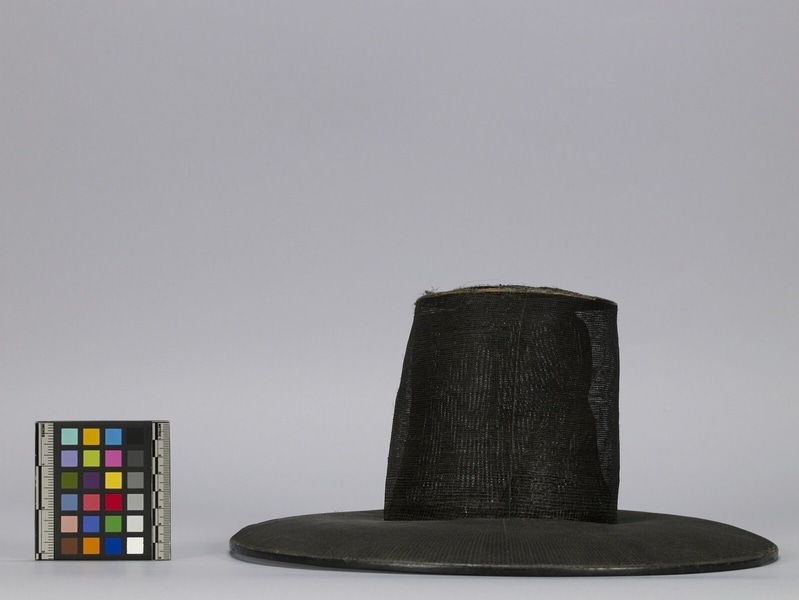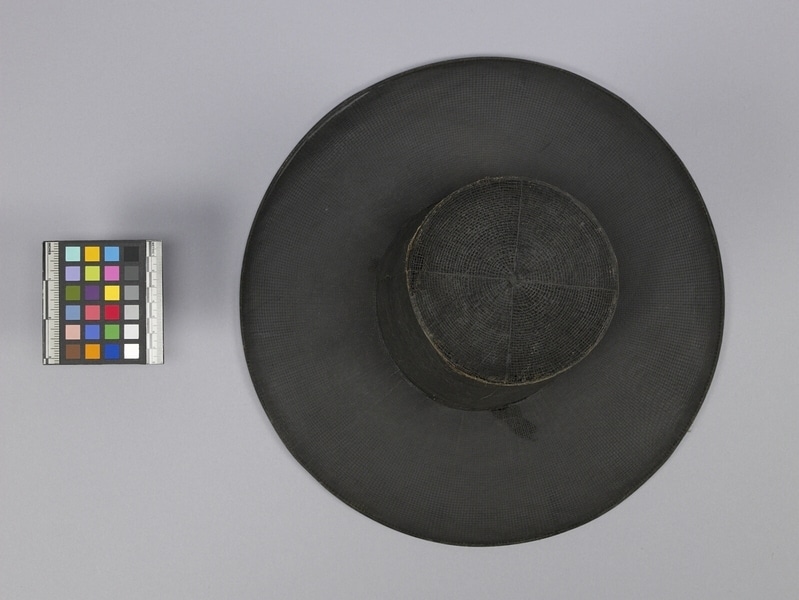Hat Item Number: Ed1.302 a-b from the MOA: University of British Columbia



Description
Hat (a) made of two layers of finely woven black horsehair with a slightly tapering cylindrical crown, and a broad circular brim. Woven on circles of thin strips of split bamboo at the top of the crown, the base of crown, and the outer brim. Chin straps are of black silk lace ribbon. The separate hat lining (b) is made of more coarsely woven black horsehair that has a seam at the top and has a cord across the centre back to gather and fit to the head.
History Of Use
Such hats were primarily worn by men of the “yangban” class, the class of families with men who were or had been government officials. The common people could not use them until these restrictions disappeared, in the late Chosun Dynasty, and they became commonly used. “Yangban” men wore them with long white coats “do-po” when going out. Their hosts would wear brimless hats called “chung sa kwan” or “sa bang kwan” at home. The hat “gat” was worn with the inner container to protect their knot of uncut long hair, called “tang-gun” and a headband to hold their hair neatly back, called “mang-gun”. The “mang-gun” could be decorated with gold and jade if the wearer was the king or high official, or with horn or bone by lower officials. In addition to the ties under the chin, the “gat” was worn with a loose cord strung with valuable materials such as amber or jade if the wearer was of higher class, or with bamboo beads if he was of lower class. After 1895 the Emperor Go-jung ordered Korean men to cut their previously uncut hair, under his policy of modernization. Those who did so no longer needed to wear the “tang-gun” or “man-gun”, but “Tang-gun” was worn even after the haircut by the local scholars.
“Gat” were sometimes made of pig’s hair instead of horsehair, and fine bamboo strips, and were covered with fine silk.
In the early and middle Chosun Dynasty the brim was wider. The father of Emperor Go-joing, Tae Won Kun, wanted to close off Korea from the Chinese and Japanese, and also wanted the Korean people to become more frugal and practical, so he ordered men to wear hats with narrower brims, saying that the wider ones were impractical and ostentatious. He also ordered them to narrow their sleeves.
Makers of such hats are called “gat-jang-in”: “gat” master. Originally there were three masters, one to make the brim, one to make the crown, and one to join them together. Some had little shops or stands in markets, where they made and sold hats. They are now supported by the government as preservers of Korean culture.
Iconographic Meaning
Such hats were a symbol of high status in Korean society.
Specific Techniques
Originally woven on a frame for brim “yang-tae-pan” and frame for crown made of wood “mo-ja-gol”. Hand sewn.
Item History
- Made in Andong, Kyongsang-Pukto, Korea during 1894
- Owned by Wilhelm Helmer before October 22, 1981
- Received from Wilhelm Helmer (Seller) and Museum of Anthropology Shop Volunteers (Funding source) on October 22, 1981
What
- Name
- Hat
- Identification Number
- Ed1.302 a-b
- Type of Item
- hat
- Material
- horse hair, silk fibre, dye, bamboo grass and lacquer
- Manufacturing Technique
- woven, lacquered and stitched
- Overall
- height 18.0 cm, diameter 34.0 cm
Who
- Culture
- Korean
- Previous Owner
- Wilhelm Helmer
- Received from
- Wilhelm Helmer (Seller) and Museum of Anthropology Shop Volunteers (Funding source)
Where
- Holding Institution
- MOA: University of British Columbia
- Made in
- Andong, Kyongsang-Pukto, Korea
When
- Creation Date
- during 1894
- Ownership Date
- before October 22, 1981
- Acquisition Date
- on October 22, 1981
Other
- Condition
- fair
- Accession Number
- 0737/0006 a-b